

Learn How to be a Preservationist - Historic Preservation. Rehabilitation and Restoration of Historic Buildings.
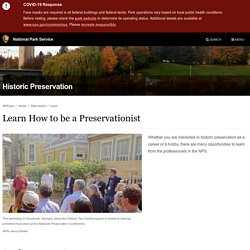
A good place to begin is with Technical Preservation Services' Preservation Brief series, which provides guidance on preserving, rehabilitating, and restoring historic buildings. If you are interested in a particular rehabilitation-related topic, try the Preservation by Topic index. Battlefield Preservation. Collection: Black/Jewish Relations research collection.
Issue Brief: Federal Grant Funding for Archives. SAA Position.
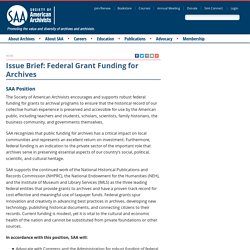
Archivist/archivist: A full-stack publishing solution involving different technologies to power digital archives. State of Oregon: State Archives - State Archives. 2.1 Temperature, Relative Humidity, Light, and Air Quality: Basic Guidelines for Preservation — NEDCC. Archives & Record Storage Building. Overview Archives and Record Storage Buildings are facilities that provide a proper environment for the purpose of storing records and materials that require permanent protection for historic and lifetime storage, upkeep, and preservation.

Archives and Record Storage Buildings must be high-performance buildings whose systems must be designed to operate permanently at a very high level with zero tolerance for failure. The often irreplaceable nature of the materials to be permanently stored and preserved in this type of building requires a life-cycle analysis and approach to its design and construction, with extensive redundancy in its building systems. To accomplish this complex mission, these buildings benefit from an inclusive, holistic, integrated or whole building design approach that optimizes and balances the various design objectives to achieve the desired high-performance building. Building Attributes. PastPerfect: The World’s Leading Collections Management Software. The digital User Guides are equipped with a search that allows you to type in the word or phrase you are looking for.
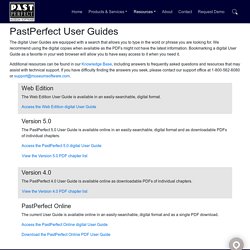
We recommend using the digital copies when available as the PDFs might not have the latest information. Bookmarking a digital User Guide as a favorite in your web browser will allow you to have easy access to it when you need it. Additional resources can be found in our Knowledge Base, including answers to frequently asked questions and resources that may assist with technical support.
If you have difficulty finding the answers you seek, please contact our support office at 1‑800‑562‑6080 or support@museumsoftware.com. Version 5.0 The PastPerfect 5.0 User Guide is available online in an easily‑searchable, digital format and as downloadable PDFs of individual chapters. Access the PastPerfect 5.0 digital User Guide Version 4.0 The PastPerfect 4.0 User Guide is available online as downloadable PDFs of individual chapters.
When the White League Militia Took Over New Orleans in 1874 It Pledged to End the “Stupid Africanization” of Government - The Reconstruction Era. The White League was one of the largest and most dangerous of the Reconstruction Era militias.
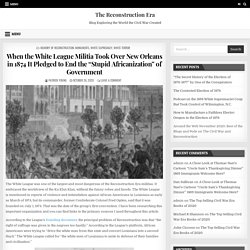
It embraced the worldview of the Ku Klux Klan, without the funny robes and hoods. The White League is mentioned in reports of violence and intimidation against African Americans in Louisiana as early as March of 1874, but its commander, former Confederate Colonel Fred Ogden, said that it was founded on July 1, 1874. That was the date of the group’s first convention. The African American Newspapers Collection. This enormous collection of African American newspapers contains a wealth of information about cultural life and history during the 1800s and is rich with first-hand reports of the major events and issues of the day, including the Mexican War, Presidential and Congressional addresses, Congressional abstracts, business and commodity markets, the humanities, world travel and religion.
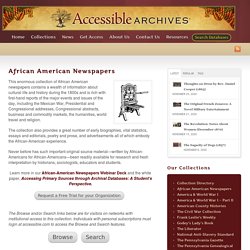
The collection also provides a great number of early biographies, vital statistics, essays and editorials, poetry and prose, and advertisements all of which embody the African-American experience. Never before has such important original source material—written by African-Americans for African-Americans—been readily available for research and fresh interpretation by historians, sociologists, educators and students. Learn more in our African-American Newspapers Webinar Deck and the white paper, Accessing Primary Sources through Archival Databases: A Student’s Perspective. Browse Search. US Government Printing Office - FDsys - Home. The Avalon Project : Documents in Law, History and Diplomacy. African American History Digital Library. Directory of Online Publications, Documents, Museum Exhibits, & Research Collections.U.S.
History > African American History> Digital Library Digital Library > History > U.S. > African American See also Leaders and Historic Men and Women ; Slavery 19th Century Documents Project "When completed this collection will include accurate transcriptions of many important and representative primary texts from nineteenth century American history, with special emphasis on those sources that shed light on sectional conflict and transformations in regional identity. " - Furman University African American Odyssey "...showcases the Library's incomparable African American collections. African American Perspectives Pamphlets from the Daniel A. [AIDS]Racial/Ethnic Disparities in Diagnoses of HIV/AIDS -- 33 States, 2001-2005 "During 2001--2004, blacks* accounted for 51% of newly diagnosed human immunodeficiency virus (HIV)/acquired immunodeficiency syndrome (AIDS) infections in the United States.
" Free Books : Download & Streaming : Ebook and Texts Archive : Internet Archive. Additional collections of scanned books, articles, and other texts (usually organized by topic) are presented here.

The American Libraries collection includes material contributed from across the United States. Institutions range from the Library of Congress to many local public libraries. Go Wayback with the Wayback Machine. Google's home page, November 1997 Retro Google?!
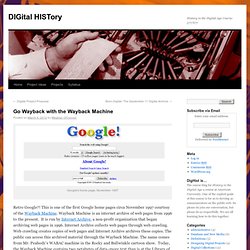
This is one of the first Google home pages circa November 1997 courtesy of the Wayback Machine. Wayback Machine is an internet archive of web pages from 1996 to the present. It is run by Internet Archive, a non-profit organization that began archiving web pages in 1996. Internet Archive collects web pages through web crawling. The greatest asset of Wayback Machine is that it is extremely easy to use. The Wayback Machine is an invaluable source for historians. National Archives and Records Administration.